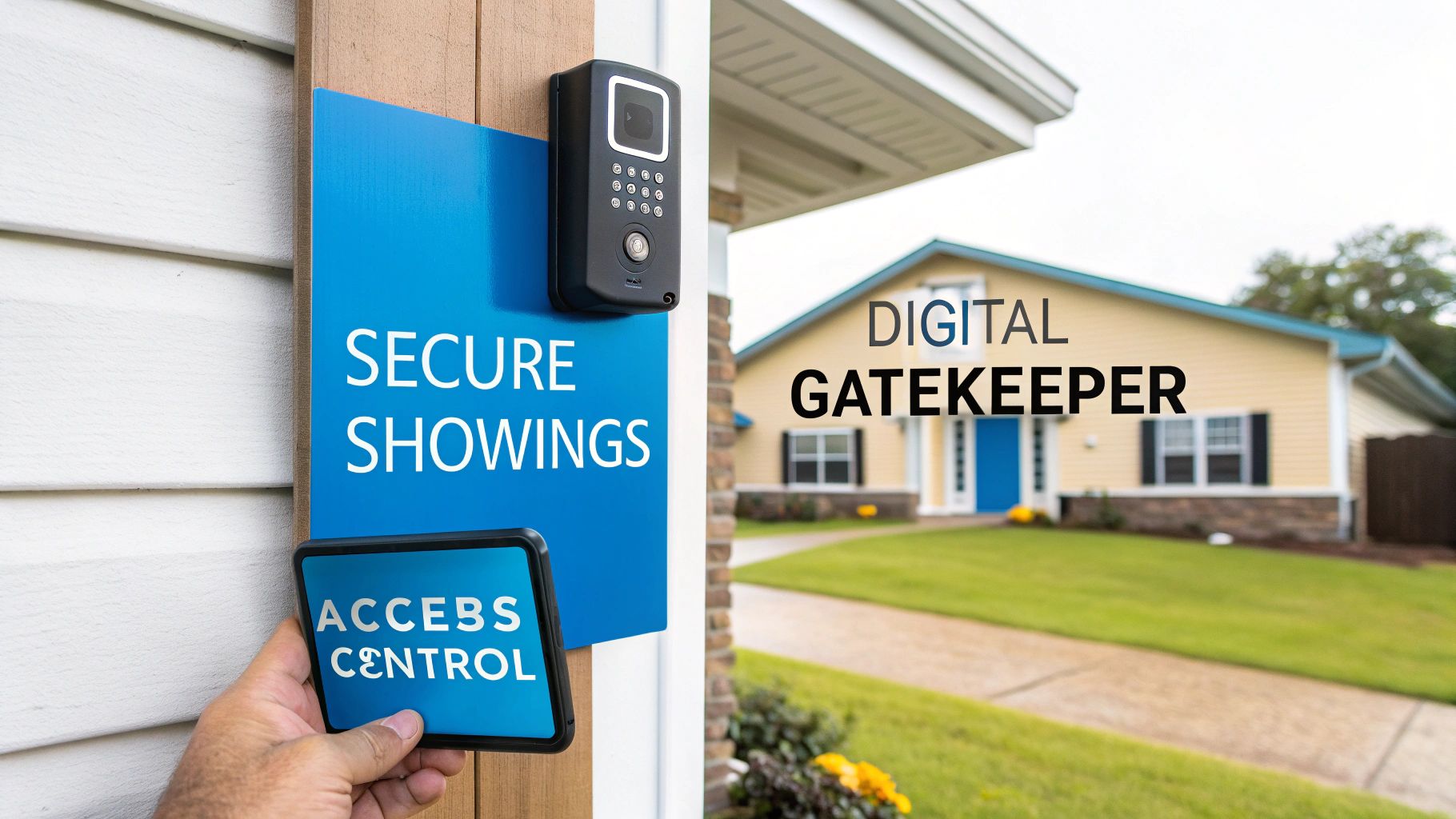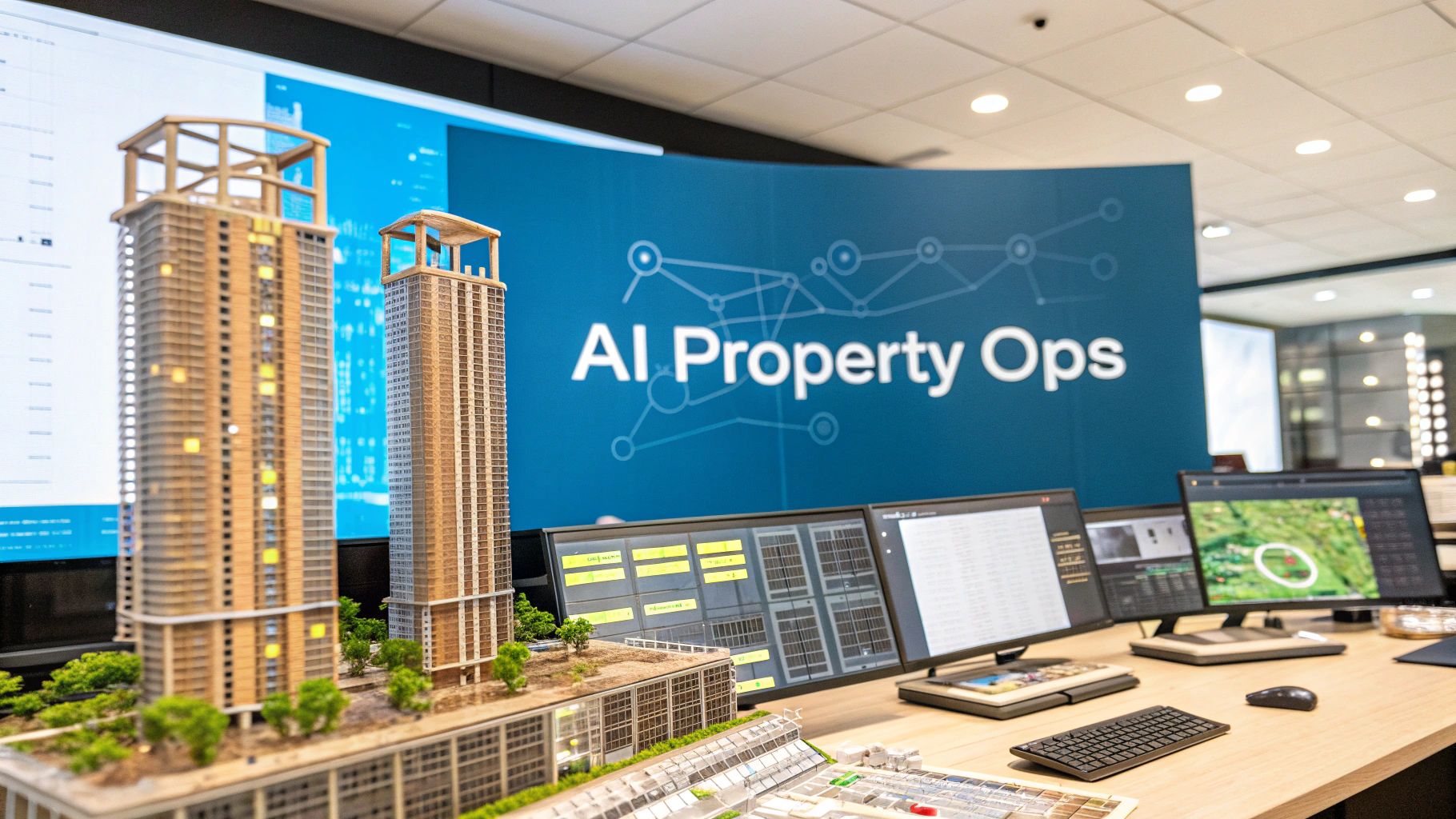For property management companies managing 1,000 to 10,000+ units, every vacant day translates to significant revenue loss across the portfolio. The primary bottleneck isn't just generating leads; it's efficiently converting them into qualified, long-term tenants while maintaining operational scale. Standardizing your vetting process with the right tenant pre screening questions is a critical lever for reducing Days on Market (DOM) and optimizing your cost per door. An inefficient, high-friction pre-screening process slows down the entire lead-to-tour pipeline, delaying lease signings and directly impacting your bottom line.
To truly optimize your tenant vetting, it's essential to understand what is pre-screening and how this initial filtering step can transform your leasing process. This initial stage allows your team to quickly identify top-tier applicants before investing resources in full showings and extensive background checks. The following guide provides a framework of essential pre-screening questions designed for scalability. Implementing these will help your operations team filter applicants effectively, mitigate portfolio-wide risk, and accelerate your speed-to-lease across a distributed portfolio without sacrificing quality. This is your first line of defense in protecting your assets and maximizing revenue.
1. Employment and Income Verification
Confirming a prospective tenant's ability to consistently pay rent is the foundational step in mitigating financial risk across a large portfolio. Among the essential tenant pre-screening questions, those focused on employment and income verification are non-negotiable. They provide a clear, data-driven answer to the most critical question: can this applicant afford the unit? For property managers overseeing hundreds or thousands of units, a single eviction can have a ripple effect on operational costs and efficiency metrics. Systematizing this verification process is key to maintaining portfolio-wide financial health and reducing costly defaults.

The industry-standard benchmark is that a tenant's gross monthly income should be 2.5 to 3 times the monthly rent. Enforcing this rule consistently across all applicants is not just good business; it's a crucial component of fair housing compliance.
How to Implement at Scale
For large portfolios, manual verification is a significant operational bottleneck. To manage this efficiently, implement a tiered and automated approach.
- Automated Verification Services: Integrate third-party income verification platforms (like The Closing Docs or Plaid) directly into your application software. These services connect to an applicant's bank account to instantly verify income and assets, dramatically reducing staff time and the potential for fraud.
- Standard Documentation: For applicants who opt out of automated services, establish a clear, non-negotiable documentation policy. This typically includes the two most recent pay stubs and a formal employment verification letter from their HR department.
- Handling Non-Traditional Income: Create a standardized process for self-employed or gig-economy workers. Require the last two years of tax returns (specifically the Schedule C) and the three most recent months of business bank statements. This provides a more accurate picture of their fluctuating income.
Actionable Tips for Enterprise-Level Screening
- Be Consistent, Not Rigid: While your 3x income requirement should be firm, be flexible on the types of documentation you accept. This accommodates various employment types without compromising your standards.
- Calculate Annually for Seasonal Workers: For applicants in industries with seasonal income (e.g., construction, tourism), request documentation covering a full 12-month period. Base your calculation on their annual gross income divided by 12 to get an accurate monthly average.
- Document Everything: Ensure your property management software logs every step of the verification process. This creates a defensible audit trail that demonstrates consistent, fair, and compliant screening procedures for every applicant. This documentation is invaluable for maintaining operational excellence and mitigating legal risks at scale.
2. Credit Score and Credit History Review
Beyond income, an applicant's credit history offers a crucial window into their financial responsibility and reliability. This is more than just a number; it's a detailed record of how they manage their financial obligations. For property management companies overseeing large, distributed portfolios, a single tenant default due to poor financial habits can lead to costly eviction proceedings and vacancy losses that impact portfolio-wide performance. A standardized credit review process is one of the most effective tenant pre-screening questions for predicting future payment behavior and ensuring portfolio stability.

Establishing a consistent, minimum credit score threshold (e.g., 650) is a critical best practice. It provides an objective, data-backed standard that, when applied uniformly to all applicants, strengthens fair housing compliance and minimizes risk across hundreds or thousands of units. This systematic approach helps prevent costly judgment errors and streamlines the approval process at scale.
How to Implement at Scale
Manually pulling and analyzing credit reports for a large volume of applicants is inefficient and prone to inconsistencies. A scalable, technology-driven approach is essential for modern property management operations.
- Integrated Tenant Screening Services: Utilize comprehensive screening platforms like RentSpree, TransUnion SmartMove, or Zillow Rental Manager. These services should integrate directly with your property management software (PMS) to provide instant, detailed credit reports, criminal background checks, and eviction histories within a single workflow.
- Establish Clear, Tiered Criteria: Define and automate your decision criteria based on credit scores. For example, applicants above a 700 score might be automatically approved, those between 640-699 might require a higher security deposit or co-signer, and those below 640 are automatically flagged for manual review or denial.
- Alternative Credit Data Protocol: Create a formal process for applicants with "thin" or no credit files. Use services that analyze alternative data, such as verified rent payment history (rent reporting) and utility payments, to assess financial responsibility for applicants who may not use traditional credit.
Actionable Tips for Enterprise-Level Screening
- Look Beyond the Score: Train your team to analyze the entire credit report. A low score from past medical debt is very different from a pattern of late rent payments or credit card charge-offs. Focus on relevant histories like rental or mortgage payments.
- Allow for Explanations: Implement a clear policy allowing applicants to provide context for negative items, such as a job loss or medical emergency. Document this information to demonstrate a fair and consistent review process.
- Automate Adverse Action Letters: Ensure your system can automatically generate and send compliant adverse action letters when an application is denied due to information found in their credit report. This is a critical Fair Credit Reporting Act (FCRA) compliance step that protects your business from legal risk.
3. Rental History and Previous Landlord References
While income verification confirms an applicant's financial capacity, their rental history predicts their future behavior as a tenant. A thorough review of past rental performance is one of the most reliable tenant pre-screening questions for forecasting lease compliance and property care. For large-scale property management companies, a single problematic tenant can consume disproportionate resources, from maintenance calls to legal proceedings. Verifying an applicant's track record with previous landlords provides invaluable, qualitative data that a credit score alone cannot offer, helping to maintain operational stability across the portfolio.

Past behavior is a strong indicator of future actions. A consistent history of on-time payments and positive landlord relationships suggests a lower-risk tenancy, which is critical for minimizing turnover and eviction-related costs at scale. For large portfolios, even a small reduction in tenant turnover can have a significant impact; according to the National Apartment Association, the average cost to turn over a unit is over $2,500, a cost that multiplies quickly across thousands of units.
How to Implement at Scale
Manually contacting multiple references for every applicant across a large portfolio is inefficient. A systematic, question-based approach is necessary to gather consistent and useful information quickly.
- Standardized Reference Questionnaire: Create a digital questionnaire within your property management software. This form should be sent to listed landlords and include specific, closed-ended questions (e.g., "Did the tenant pay rent on time every month? Yes/No," "Were any lease violations issued? Yes/No," "Was the full security deposit returned? Yes/No"). This standardizes data collection and makes it easy to compare applicants.
- Tiered Verification Process: Prioritize contacting the two most recent landlords, as this provides the most relevant data. Instruct your team to always attempt contact at least twice. If a landlord is unresponsive, document the attempts and proceed, noting the lack of verification. This creates a consistent, defensible process.
- Red Flag Identification: Develop a clear "red flag" system. For example, a reference from a family member, a refusal to provide previous landlord contact information, or a report of property damage should trigger a secondary review by a senior property manager.
Actionable Tips for Enterprise-Level Screening
- Ask Specific, Fact-Based Questions: Avoid vague questions like "Were they a good tenant?" Instead, ask: "Did they have any late payments in the last 12 months?" or "Did you receive any documented complaints about this tenant?"
- Verify the Landlord: When possible, cross-reference the landlord’s name with property tax records to confirm they actually own the property. This helps prevent applicants from using friends as fake references.
- Document Every Interaction: Log all calls, emails, and completed questionnaires in your central management system. This documentation is crucial for demonstrating fair housing compliance and provides a clear audit trail for every application processed.
4. Criminal Background Check
A systematic criminal background check is a critical component of a comprehensive risk management strategy for large rental portfolios. Beyond individual safety, this step protects the community, the property, and your brand's reputation. For property managers overseeing geographically dispersed assets, ensuring a consistent and legally compliant screening process is paramount. This one of the most vital tenant pre-screening questions helps identify applicants whose history may pose a direct threat to the well-being of other residents or the integrity of the asset, mitigating potential liability at scale.

The key is not to implement a blanket ban but to create a nuanced, defensible policy based on relevance and risk. Adhering strictly to Fair Housing Act (FHA) and HUD guidelines is non-negotiable, as improper use of criminal records can lead to discrimination claims.
How to Implement at Scale
Manual criminal record checks are unfeasible and legally risky for large portfolios. A centralized and automated approach ensures consistency and compliance.
- Integrated Screening Services: Partner with a reputable, FCRA-compliant screening provider that integrates directly with your property management software. This automates the check across national, federal, and state databases and provides a standardized report format for efficient review.
- Develop a Written Policy Matrix: Create a clear, written policy that specifies which types of convictions are relevant to tenancy. This matrix should outline your criteria, such as offenses against persons or property (e.g., arson, burglary, violent crimes), and establish lookback periods. This matrix becomes your operational playbook, ensuring every application is judged by the same standards.
- Individualized Assessment Protocol: For any applicant flagged by the screening, establish a formal "individualized assessment" process as recommended by HUD. This protocol should guide your team in considering the nature and severity of the crime, the time that has passed, and any evidence of rehabilitation.
Actionable Tips for Enterprise-Level Screening
- Focus on Relevance, Not Arrests: Your policy must distinguish between arrests and convictions. Only consider convictions, and focus solely on those that present a demonstrable risk to other tenants or property.
- Standardize Your Lookback Period: A common, legally defensible lookback period is seven years. Applying this consistently across your portfolio simplifies decision-making and reduces the risk of discriminatory practices.
- Train and Document: Provide regular training to your leasing and management staff on your criminal history policy and Fair Housing laws. Document every decision, especially those involving an individualized assessment, within your property management system to create a clear audit trail. This documentation is your best defense against potential legal challenges.
5. Reason for Moving
While seemingly a simple conversational question, understanding an applicant's reason for moving is a crucial diagnostic tool for large-scale property managers. The answer provides vital context that quantitative data, like credit scores, cannot. It helps forecast tenant stability, uncover potential red flags that could impact portfolio performance, and predict future tenancy duration. For property managers overseeing geographically dispersed assets, identifying a potentially problematic tenancy before it begins is essential for maintaining operational efficiency and protecting revenue across the entire portfolio.
The answer to this tenant pre-screening question helps categorize applicant motivation. A move for a job relocation suggests stability, whereas a move to be closer to family or amenities indicates a focus on lifestyle. Both are generally positive indicators. Conversely, vague or evasive answers about leaving a previous tenancy can signal issues that warrant deeper investigation, such as a pending eviction or poor landlord relationship.
How to Implement at Scale
Integrating this qualitative question into a high-volume, standardized screening process requires a systematic approach to ensure fairness and consistency.
- Standardized Application Field: Include a mandatory, open-ended field in your digital application titled "Reason for Leaving Your Current Residence." This ensures the question is asked of every applicant, creating a uniform data point for comparison and supporting fair housing compliance.
- Keyword Flagging System: Configure your property management software to flag specific keywords or phrases in the applicant's response. For instance, terms like "eviction," "dispute," "conflict," or "landlord issue" can automatically trigger a manual review by a senior leasing agent or property manager.
- Cross-Reference with Landlord Verification: Use the applicant's stated reason for moving as a starting point for the previous landlord verification call. Frame your question to the former landlord directly: "The applicant mentioned they are moving to be closer to their new job. Does that align with your understanding of their departure?" This helps verify the applicant's honesty and uncovers discrepancies.
Actionable Tips for Enterprise-Level Screening
- Look for Positive Motivators: Prioritize applicants whose reasons indicate a life improvement, such as a new job, needing more space for a growing family, or purchasing a home (if they need a short-term rental). These are signs of a stable, forward-moving individual less likely to cause issues.
- Document and Categorize Responses: In your management software, create a dropdown menu or tagging system to categorize responses (e.g., "Job Relocation," "Family Reasons," "Seeking Upgrade," "Rent Increase"). Over time, this data can reveal trends between move-in reasons and tenancy outcomes, like lease renewals or evictions.
- Train Staff on Neutral Follow-Up Questions: Equip your leasing team with a script of neutral, non-discriminatory follow-up questions to clarify vague answers. Instead of asking "What was wrong with your old landlord?", ask "Could you tell me more about what you're looking for in your next rental home and community?" This reframes the conversation positively while still gathering necessary information.
6. Occupancy and Authorized Residents
Accurately identifying every individual who will reside in a unit is a crucial compliance and risk management step for large-scale property managers. Among the essential tenant pre-screening questions, those clarifying occupancy ensure that every adult resident is properly vetted and bound by the lease agreement. For portfolios spanning hundreds or thousands of units, failing to document all occupants can lead to unauthorized residents, increased wear and tear, and significant legal complications. Systematizing this process is vital for maintaining portfolio-wide compliance and mitigating liability.
Enforcing occupancy limits based on local and federal housing laws (such as the Fair Housing Act's guidelines, often interpreted as "two persons per bedroom") protects the property asset and ensures a consistent, defensible standard across all applications. This prevents overcrowding and aligns operations with legal requirements.
How to Implement at Scale
Managing occupancy verification across a large portfolio requires a clear, automated workflow integrated directly into your application process. A manual approach creates inconsistencies and increases the risk of non-compliance.
- Mandatory Application for All Adults: Configure your property management software to require every individual 18 years or older to submit a separate application. This should be a non-negotiable step that triggers the full screening process, including background and credit checks, for each adult resident.
- Standardized Occupancy Questions: Include specific questions in the application form, such as "List all individuals, including minors, who will be occupying the unit." This creates a formal record of the intended residents from the outset.
- Lease Clause Automation: Use software to automatically populate the lease agreement with the names of all approved adult and minor occupants. This ensures the final legal document accurately reflects the information gathered during screening, leaving no room for ambiguity.
Actionable Tips for Enterprise-Level Screening
- Define and Display Occupancy Limits: Clearly state the maximum occupancy for each unit type in your online listings and marketing materials. This pre-qualifies applicants and reduces the volume of applications that do not meet your property’s standards.
- Establish a "Guest vs. Tenant" Policy: Create a standardized policy, included in the lease, that defines the maximum number of consecutive days a guest can stay before they are considered an unauthorized tenant. This provides a clear framework for enforcement.
- Document and Train on Fair Housing Laws: Ensure your entire team is trained on Fair Housing regulations regarding familial status. Your policies must be applied consistently to all applicants, whether they are a family with children, a group of students, or a single individual, to avoid any perception of discrimination.
7. Pet and Animal Policies
Navigating pet and animal policies is a critical function for large-scale property management, directly impacting vacancy rates, property damage costs, and legal compliance. Among the most important tenant pre-screening questions are those that clarify an applicant's situation regarding animals. A well-defined, consistently applied policy can transform a potential liability into a competitive advantage by tapping into the massive market of responsible pet-owning renters. For portfolios with hundreds or thousands of units, standardizing these questions prevents Fair Housing Act (FHA) violations and streamlines the leasing process.
Failing to distinguish between pets, service animals, and emotional support animals (ESAs) can lead to costly legal challenges and operational chaos. A systematic approach ensures compliance, protects the asset, and provides clarity for both applicants and leasing staff across your entire portfolio.
How to Implement at Scale
For large portfolios, managing animal-related inquiries and documentation requires a standardized, automated system integrated into your application workflow.
- Differentiated Digital Questionnaires: Use conditional logic in your online application. The initial question should be, "Do you have any animals that will be living in the unit?" If the answer is yes, the form should automatically branch to separate, compliant questionnaires for pets versus assistance animals (service animals and ESAs).
- Standardized Pet Screening: Integrate a third-party pet screening service (like PetScreening.com) into your process. This offloads the verification of pet information, veterinary records, and assistance animal documentation to a specialized provider, ensuring FHA compliance and consistent risk assessment for every applicant.
- Clear Assistance Animal Protocol: Establish a clear internal process for handling assistance animal requests. While you cannot charge fees or deposits for service animals or ESAs, you can require reliable documentation for an ESA that verifies the individual has a disability and a disability-related need for the animal. Train your staff on the specific, limited questions they are legally allowed to ask.
Actionable Tips for Enterprise-Level Screening
- Distinguish Legally, Not Personally: Your policies must strictly adhere to the legal definitions. A service animal is not a "pet" under the FHA and is not subject to pet fees, rent, or breed/size restrictions. Having a clear policy also gives you a framework for why you should consider allowing pets at your rental. Learn more about the benefits of pet-friendly policies on showdigs.com.
- Set Clear Pet Rules: For non-assistance animals, clearly define your rules in the lease agreement. This includes any breed or size restrictions, the exact amount for pet deposits or monthly pet rent, and rules regarding waste cleanup and noise. Consistency across the portfolio is key to avoiding discrimination claims.
- Document All Communications: Ensure every interaction, request, and accommodation related to animals is logged in your property management software. This creates an unassailable record demonstrating your consistent, legally compliant process, which is invaluable for mitigating risk at scale.
8. Emergency Contact and Personal References
Beyond financial and rental history, a comprehensive screening process includes qualitative assessments and crucial safety protocols. Among the essential tenant pre-screening questions, those targeting emergency contacts and personal references serve a dual purpose. They provide a layer of character verification while simultaneously building a safety net for unforeseen circumstances. For large-scale operators, having this information standardized and accessible across the portfolio is vital for both risk management and responsible property stewardship. A single unresolved emergency can escalate into a significant liability or operational disruption.
Obtaining this information is a standard part of a thorough application process. While references provide insight into an applicant’s reliability, the emergency contact is a non-negotiable piece of data for the final lease agreement, ensuring you can reach someone if the tenant is unresponsive or incapacitated.
How to Implement at Scale
Manually contacting references for thousands of applicants is inefficient. The key is to systematize the collection and verification process to gather meaningful data without creating an operational bottleneck.
- Tiered Reference System: Differentiate between emergency contacts and character references. Emergency contact information should be mandatory for all approved leases and entered directly into your property management software's tenant portal. Character reference checks can be a secondary step, used for applicants who may be on the borderline of your qualification criteria.
- Standardized Question Templates: Create a brief, standardized set of questions for your leasing team to ask references. For personal references, ask about their relationship to the applicant, how long they’ve known them, and if they would recommend them as a reliable neighbor. For professional references, inquire about their work ethic and professionalism.
- Verification Protocols: Instruct your team to verify the relationship claimed by the applicant. A quick cross-reference on a social media platform or a question like, "How did you and [Applicant's Name] first meet?" can help confirm the legitimacy of the reference. Keep records of these conversations logged in the applicant's file in your CRM or PMS.
Actionable Tips for Enterprise-Level Screening
- Prioritize Emergency Contacts: While personal references are useful, the emergency contact is critical. Ensure this information is collected before lease signing and that tenants are prompted to update it annually.
- Ask for a Mix of References: Request one professional reference (like a supervisor or long-term colleague) and one personal reference. This provides a more balanced view of the applicant's character than relying solely on friends or family.
- Document and Store Securely: All reference information and contact logs must be stored securely to comply with privacy laws. Use your property management software to create an auditable trail, demonstrating a consistent and fair process for every applicant. This documentation is also crucial for building stronger tenant relationships. For more insights, explore these communication tips for improving the tenant-manager relationship.
Tenant Pre-Screening Criteria Comparison
Integrating Pre-Screening into a High-Velocity Leasing Funnel
The tenant pre-screening questions we've explored, from income verification to pet policies, are more than just a procedural checklist. For enterprise-level property management companies, they represent the foundational data points that power a scalable, high-velocity leasing funnel. Mastering these inquiries isn't about creating barriers; it's about building efficient, data-driven pathways that connect the most qualified applicants to your properties with unprecedented speed. This strategic front-loading of qualification is what separates a reactive leasing process from a proactive, revenue-generating engine.
From Manual Gatekeeping to Automated Qualification
Moving beyond a simple list, the true value emerges when you integrate these tenant pre-screening questions into your operational workflow and technology stack. By systemizing this process, you transform it from a manual, time-intensive task into a strategic asset. The goal is to automatically filter and segment leads the moment they inquire, ensuring that your team's valuable time is spent only on high-intent, pre-vetted prospects.
This shift has a direct and measurable impact on key performance indicators for large portfolios:
- Drastic DOM Reduction: By eliminating unqualified tours, you ensure that every property showing has a higher probability of conversion. This accelerates the leasing cycle, directly cutting down Days on Market and minimizing vacancy loss across your portfolio. Consider the revenue impact: for a 2,000-unit portfolio with an average rent of $1,800/month, every single day shaved off your average DOM adds $120,000 in monthly revenue.
- Optimized Lead-to-Tour Conversion: Your conversion rates for qualified leads will skyrocket. Instead of tracking raw inquiries, you can focus on the metric that truly matters: the conversion of tour-ready applicants, which is a leading indicator of lease signings.
- Enhanced Operational Efficiency: Automating initial screening frees up your leasing agents and property managers from the repetitive task of chasing down basic information. Their efforts can be redirected toward higher-value activities like nurturing relationships with top-tier applicants and closing deals faster.
The Strategic Advantage of a Systemized Approach
Ultimately, a robust pre-screening framework allows you to make smarter, faster decisions at scale. You are no longer just filling vacancies; you are strategically placing reliable, long-term residents who are less likely to result in turnover or payment issues. This consistency is crucial for maintaining portfolio health and predictable revenue streams, especially when managing hundreds or thousands of distributed units.
The insights gained from these questions create a powerful feedback loop. You can analyze which lead sources generate the most qualified applicants, refine your marketing spend, and continually optimize your leasing funnel for maximum ROI. By viewing your tenant pre-screening questions as the first, most critical step in your leasing automation, you build a resilient, scalable operation prepared for future growth. This is how market leaders maintain a competitive edge, turning a standard industry practice into a cornerstone of financial performance.
Ready to turn your pre-screening process into a high-speed leasing engine? Showdigs integrates seamlessly with your qualification criteria, automating the entire lead-to-tour process for your pre-vetted applicants. See how our platform can drastically reduce your Days on Market and optimize operations across your entire portfolio by scheduling a demo at Showdigs today.







